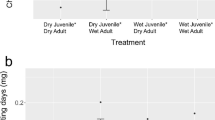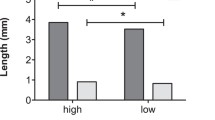Abstract
This study examines how Choristoneura rosaceana male quality, as determined by larval diet, age and mating history, affects the reproductive success of both sexes. While the size of the spermatophore produced at first mating increased linearly with male age, the frequency of mating was significantly higher for middle-aged males (2–4 days old) than younger (0–2 days old) or older (6–8 days old) individuals, when both sexes were fed on artificial diet. However, the duration of copulation was longer in couples with older than younger males. The observed age-related changes in spermatophore size had no significant effect on female longevity, fecundity or fertility, suggesting no direct relationship between male investment and spermatophore size under these experimental conditions. Different larval food sources (artificial diet, maple and hazelnut) did not affect the proportion of 2-day-old virgin males that mated; however, the proportion that remated was significantly higher for males reared on high-quality food (maple and artificial diet) than those on hazelnut, a poorer food source. There was a 5-fold decline in spermatophore size between the first and second matings on all diets, but female reproductive output was reduced by only 25%. In contrast, while the first spermatophore produced by males on hazelnut was 1.5 times smaller than those produced on maple and artificial diet, the fecundity of their mates was 40% less than those mated with high-quality virgin males. These results provide additional support to the idea that spermatophore size is not a valuable indicator of male quality. Most tethered females placed in the field during the first flight period mated with virgin males (based on the size of the spermatophore), suggesting that female choice exists in this species. These results are discussed in relation to the incidence of polyandry in naturally occurring populations of Choristoneura and the potential use of size and/or chemical cues by females to assess male quality.
Similar content being viewed by others
References
Anderson TW (1958) An introduction to multivariate statistical analysis. Wiley, New York
Benz G (1969) Influence of mating, insemination, and other factors on oögenesis and oviposition in the moth Zeiraphera diniana J. Insect Physiol 35:55–71
Birch MC, Poppy GM, Baker TC (1990) Scents and eversible scent structures of male moths. Annu Rev Entomol 35:25–58
Boggs CL (1981) Nutritional and life-history determinants of resource allocation in holometabolous insects. Am Nat 117:692–709
Boggs CL (1990) A general model of the role of male-donated nutrients in female insects reproduction. Am Nat 136:598–617
Boggs C, Watt WB (1981) Population structure of pierid butterflies. IV. Genetic and physiological investment in offspring by male Colias. Oecologia 50:320–324
Bollinger JF, Shorey HH, Gaston LK (1977) Effect of several temperature regimes on the development and timing of responsiveness of males of Trichoplusia ni to the female sex pheromone. Environ Entomol 6:311–314
Boppré M (1986) Insects pharmacophagously utilizing defensive plant chemicals (Pyrrolizidine alkaloids). Naturwissenschaften 73:17–26
Boppré M, Schneider D (1985) Pyrrolizidine alkaloids quantitatively regulate both scent organ morphogenesis and pheromone biosynthesis in male Creatonotos moths (Lepidoptera: Arctiidae). J Comp Physiol A 157:569–577
Brower JH (1975) Sperm precedence in the Indian meal moth, Plodia interpunctella. Ann Entomol Soc Am 68:78–80
Brown KS Jr (1984) Adult-obtained pyrrolizidine alkaloids defend ithiomiine butterflies against a spider predator. Nature 309:707–709
Carrière Y (1992a) Host plant exploitation within a population of a generalist herbivore, Choristoneura rosaceana. Entomol Exp Appl 65:1–10
Carrière Y (1992b) Larval dispersal from potential hosts within a population of a generalist herbivore, Choristoneura rosaceana. Entomol Exp Appl 65:11–19
Chapman PJ, Lienk SE, Dean RW (1968) Bionomics of Choristoneura rosaceana. Ann Entomol Soc Am 61:285–290
Conner WE, Eisner T, Vander Meer RK, Guerrero A, Meinwald J (1981) Precopulatory sexual interaction in an arctiid moth (Utetheisa ornatrix): role of a pheromone derived from dietary alkaloids. Behav Ecol Sociobiol 9:227–235
Delisle J (1992) Age-related changes in the calling behaviour and the attractiveness of obliquebanded leafroller virgin females, Choristoneura rosaceana, under different constant and fluctuating temperature conditions. Entomol Exp Appl 63:55–62
Delisle J (1995) Effect of male and female age on the mating success of obliquebanded leafroller Choristoneura rosaceana (Lepidoptera: Tortricidae), under different ecological conditions. J Insect Behav 8(6):781–799
Delisle J, Royer L (1994) Changes in pheromone titer of obliquebanded leafroller, Choristoneura rosaceana, virgin females as a function of time of day, age and temperature. J Chem Ecol 20:45–69
Dixon WJ (ed) (1990) BMDP statistical software manual. University of California Press, Berkeley
Drummond BA II (1984) Multiple mating and sperm competition. In: Smith RL (ed) Sperm competition and the evolution of animal mating systems. Academic Press, New York, pp 291–370
Dussourd DE, Ubik K, Harvis C, Resch J, Meinwald J, Eisner T (1988) Biparental defensive endowment of eggs with acquired plant alkaloid in the moth Utetheisa ornatrix. Proc Natl Acad Sci 85:5992–5996
Dussourd DE, Harvis CA, Meinwald J, Eisner T (1989) Paternal allocation of sequestered plant pyrrolizidine alkaloid to eggs in the danaine butterfly, Danaus gilippus. Experientia 45:896–898
Dussourd DE, Harvis CA, Meinwald J, Eisner T (1991) Pheromonal advertisement of a nuptial gift by a male moth Utetheisa ornatrix. Proc Natl Acad Sci 88:9224–9227
Fitzpatrick SM, McNeil JN (1989) Lifetime mating potential and reproductive success in males of the true armyworm, Pseudaletia unipuncta (Haw.) (Lepidoptera: Noctuidae). Funct Ecol 3:37–44
Fitzpatrick SM, McNeil JN, Dumont S (1988) Does male pheromone effectively inhibit competition among courting true armyworm males (Lepidoptera: Noctuidae)? Anim Behav 36:1831–1835
George JA, Howard MG (1968) Insemination without spermatophores in the oriental fruit moth, Grapholitha molesta (Lepidoptera: Tortricidae). Can Entomol 100:190–192
Giebultowicz JM, Bell RA, Imberski RB (1988) Circadian rhythm of sperm movement in the male reproductive tract of the gypsy moth, Lymantria dispar. J Insect Physiol 34:527–532
Greenfield MD (1982) The question of paternal investment in Lepidoptera: male-contributed proteins in Plodia interpunctella. Int J Invertebr Reprod 5:323–330
Henneberry TJ, Leal MP (1979) Pink bollworm: Effects of temperature, photoperiod and light intensity, moth age, and mating frequency on oviposition and egg viability. J Econ Entomol 72:489–492
Huynh H, Feldt LS (1970) Conditions under which mean square ratios in repeated measurements designs have exact F-distributions. J Am Stat Assoc 65:1582–1589
Jones KN, Odendaal FJ, Ehrlich PR (1986) Evidence against the spermatophore as paternal investment in checkerspot butterflies (Euphydryas: Nymphalidae). Am Midl Nat 116:1–6
Kehat M, Gordon D (1977) Mating ability, longevity and fecundity of the spiny bollworm, Earias insulana (Lepidoptera: Noctuidae). Entomol Exp Appl 22:267–273
Krasnoff SB, Roelofs WL (1989) Quantitative and qualitative effect of larval diet on male scent secretions of Estigmene acrea, Phragmatobia fuliginosa, and Pyrrharctia isabella (Lepidoptera: Arctiidae) J Chem Ecol 15:1077–1093
LaChance LE, Richard RD, Ruud RL (1977) Movement of eupyrene sperm bundles from the testis and storage in the ductus ejaculatoris duplex of the male pink bollworm: effects of age, strain, irradiation, and light. Ann Entomol Soc Am 70:647–651
Lederhouse RC (1981) The effect of female mating frequency on egg fertility in the black swallowtail, Papilio polyxenes asterius (Papilionidae). J Lepid Soc 35:266–277
Lederhouse RC, Ayres MP, Scriber JM (1990) Adult nutrition affects male virility in Papilio glaucus L. Funct Ecol 4:743–751
Marks RJ (1976) Mating behaviour and fecundity of the red bollworm Diparopsis castanea Hmps. (Lepidoptera: Noctuidae). Bull Entomol Res 66:145–158
Marshall LD (1988) Small male advantage in mating in Parapediasia teterrella and Agriphila plumbifimbriella (Lepidoptera: Pyralidae). Am Midl Nat 119:412–419
Marshall LD, McNeil JN (1989) Spermatophore mass as an estimate of male nutrient investment: a closer look in Pseudaletia unipuncta (Haworth) (Lepidoptera: Noctuidae). Funct Ecol 3:605–612
Oberhauser KS (1988) Male monarch butterfly spermatophore mass and mating strategies. Anim Behav 36:1384–1388
Oberhauser KS (1989) Effects of spermatophores on male and female monarch butterfly reproductive success. Behav Ecol Sociobiol 25:237–246
Outram I (1971) Aspects of mating in the spruce budworm, Choristoneura fumiferana (Lepidoptera: Tortricidae). Can Entomol 103:1121–1128
Palaniswamy P, Seabrook WD, Ross RJ (1979) Precopulatory behavior of males and perception of a potential male pheromone in spruce budworm, Choristoneura fumiferana. Ann Entomol Soc Am 72:544–551
Parker GA (1970) Sperm competition and its evolutionary consequences in the insects. Biol Rev 45:525–567
Phelan PL, Baker TC (1986) Male-size-related courtship success and intersexual selection in the tobacco moth, Ephestia elutella. Experientia 42:1291–1293
Pivnick KA, McNcil JN (1987) Puddling in butterflies: sodium affects reproductive success in Thymelicus lineola. Physiol Entomol 12:461–472
Pliske TE (1975) Attraction of Lepidoptera to plants containing pyrrolizidine alkaloids. Environ Entomol 4:455–473
Riemann JG, Thorson BJ (1978) Adult Mediterranean flour moth: effects of temperature on sperm production and periodicity of testis and vas deferens activity. Ann Entomol Soc Am 71:575–580
Royer L, McNeil JN (1993) Male investment in the European corn borer, Ostrinia nubilalis (Lepidoptera: Pyralidae): impact on female longevity and reproductive performance. Funct Ecol 7:209–215
Rutowski RL (1979) The butterfly as an honest salesman. Anim Behav 26:892–903
Rutowski RL (1980) Courtship solicitation by females of the checkered white butterfly, Pieris protodice. Behav Ecol Sociobiol 7:113–117
Rutowski RL, Gilchrist GW (1986) Copulation in Colias eurytheme (Lepidoptera: Pieridae). Am Midl Nat 105:334–340
Rutowski RL, Gilchrist GW, Terkanian B (1987) Female butterflies mated with recently mated males show reduced reproductive output. Bchav Ecol Sociobiol 20:319–322
SAS Institute (1990) SAS user's guide: basics. SAS Institute, Cary
Shory HH,(1963) The biology of Trichoplusia ni (Lepidoptera: Noctuidae). II. Factors affecting adult fecundity and longevity. Ann Entomol Soc Am 56:476–480
Shory HH, Hale RL (1965) Mass rearing of the larvae of nine noctuid species on a simple artificial medium. J Econ Entomol 58:522–524
Sims SR (1979) Aspects of mating frequency and reproductive maturity in Papilio zelicaon. Am Midl Nat 102:36–50
Smith LM (1970) Sexual activity and egg fertility of the peach tree borer. J Econ Entomol 63:1909–1910
Stockel J (1971) Variation de la taille du spermatophore en fonction de son rang d'émission par le mâle de Sitotroga cerealella Oliv. (Lep. Gelechiidae). C R Acad Sci Paris D 272:2713–2716
Sugawara T (1979) Stretch reception in the bursa copulatrix of the butterfly, Pieris rapae crucivorea, and its role in behaviour. J Comp Physiol 130:191–199
Svärd L (1985) Paternal investment in a monandrous butterfly Pararge aegeria. Oikos 45:66–70
Svärd L, Wiklund C (1986) Different ejaculate delivery strategies in first versus subsequent matings in the swallowtail butterfly Papilio machaon L. Behav Ecol Sociobiol 18:325–330
Svärd L, Wiklund C (1988) Fecundity, egg weight, and longevity in relation to multiple matings in females of the monarch butterfly. Behav Ecol Sociobiol 23:39–43
Svärd L, Wiklund C (1991) The effect of ejaculate mass on female reproductive output in the European swallowtail butterfly, Papilio machaon (L.) (Lepidoptera: Papilionidae). J Insect Behav 4:33–41
Swaby JA, Daterman GE, Sower LL (1987) Mating behavior of Douglas-fir tussock moth, Orgyia pseudotsugata (Lepidoptera: Lymantriidae), with special reference to effects of female age. Ann Entomol Soc Am 80:47–50
Thibout E (1975) Analyse des causes de l'inhibition de la réceptivité sexuelle et de l'influence d'une éventuelle seconde copulation sur la reproduction chez la teigne du poireau, Acrolepia assectella (Lepidoptera: Plutellidae). Entomol Exp Appl 15:105–116
Thibout E, Rhan R (1972) Etude de la variabilité du volume et du pouvoir fécondant des spermatophores successifs d'Acrolepia assectella (Lepidoptera: Plutellidae). Entomol Exp Appl 15:443–454
Tóth M (1979) Pheromone-related behaviour of Mamestra suasa (Schiff.): daily rhythm and age dependence. Acta Phytophatol Acad Sci Hung 14:189–194
Trivers RL (1972) Parental investment and sexual selection. In: Campbell B (ed) Sexual selection and the descent of man, 1871–1971. Aldine, Chicago, pp 136–179
Turgeon JJ, McNeil JN (1983) Modifications of the calling behaviour of Pseudaletia unipuncta. Entomol Exp Appl 31:1015–1022
Watanabe M (1988) Multiple matings increase the fecundity of the yellow swallowtail butterfly, Papilio xuthus L., in summer generations. J Insect Behav 1:17–29
Watt WB (1986) Power and efficiency as indexes of fitness in metabolic organization. Am Nat 127:629–653
Author information
Authors and Affiliations
Rights and permissions
About this article
Cite this article
Delisle, J., Bouchard, A. Male larval nutrition in Choristoneura rosaceana (Lepidoptera: Tortricidae): an important factor in reproductive success. Oecologia 104, 508–517 (1995). https://doi.org/10.1007/BF00341349
Received:
Accepted:
Issue Date:
DOI: https://doi.org/10.1007/BF00341349




